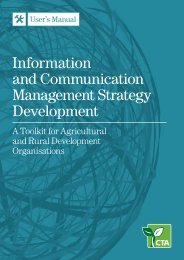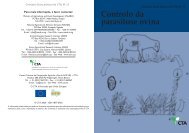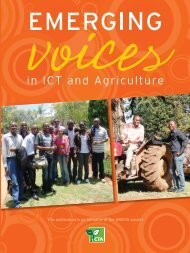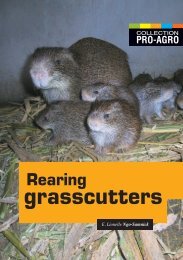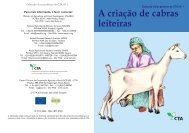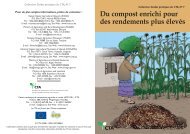Policy framework for Pastoralism in Africa
Policy framework for Pastoralism in Africa
Policy framework for Pastoralism in Africa
- No tags were found...
You also want an ePaper? Increase the reach of your titles
YUMPU automatically turns print PDFs into web optimized ePapers that Google loves.
to pasture and water resources are often <strong>in</strong>spired by Islamic laws. Typically, pastoral traditiondictates that land is a communal resource.Although conflict between pastoralists and sedentary farmers is commonly reported, there are alsonumerous examples of peaceful co-existence and mutually beneficial economic exchanges. Forexample, pastoral communities based <strong>in</strong> the Sahelian zone can practice transhumance which isbased on peace agreements between their traditional rulers and the traditional rulers of crop farmers.This practice can be seen <strong>in</strong> the common exploitation of pasture land extend<strong>in</strong>g from the wetpla<strong>in</strong>s of the Logone River <strong>in</strong> the far north region of Cameroon to Lake Lere <strong>in</strong> Chad.The social assets of pastoralist groups also <strong>in</strong>clude the <strong>in</strong>digenous social support systems which tovary<strong>in</strong>g degrees, are <strong>in</strong>tended to assist poorer members of the community. These systems may targethouseholds with relative few animals or those which have suddenly lost animals due to disease,flood<strong>in</strong>g or other causes. Female-headed households may also be targeted. These local systems arebased on loans or gifts of livestock or livestock products, and <strong>for</strong> Muslims, the giv<strong>in</strong>g of alms<strong>in</strong>cludes richer households donat<strong>in</strong>g livestock to poorer households.In constrast to these strong aspects of pastoralist culture and social organization are other beliefsand practices which h<strong>in</strong>der development and the <strong>in</strong>tegration of pastoralists <strong>in</strong>to wider society. Someof these features are not restricted only to pastoralists <strong>in</strong> <strong>Africa</strong>, but are also evident <strong>in</strong> variousnon-pastoral areas. A major problem is the low status of women <strong>in</strong> pastoral societies, as evidentfrom statistics on the health and education of pastoral girls and women. Some communities ma<strong>in</strong>ta<strong>in</strong>the tradition of marry<strong>in</strong>g girls of very young age, often to elderly men, with girls sometimesdest<strong>in</strong>ed to their future husbands at birth. The educations of girls can be a taboo and women haveno <strong>in</strong>heritance right, and are isolated from decision-mak<strong>in</strong>g concern<strong>in</strong>g them directly or <strong>in</strong>directly.When women do have the right to own or manage livestock, it can be restricted to sheep and goats,whereas men keep control of more valuable camels and cattle. Female genital mutilation is practiced<strong>in</strong> some pastoralist communities, <strong>in</strong>clud<strong>in</strong>g extreme <strong>for</strong>ms of this practice, with result<strong>in</strong>g lifelonghealth implications <strong>for</strong> women. These health problems are exacerbated by poor access to qualityhealthcare, <strong>in</strong>clud<strong>in</strong>g maternal healthcare.Another serious concern <strong>in</strong> pastoralist areas is conflict. The causes of conflict can <strong>in</strong>clude poorgovernance, but other types of conflict relate to cultural norms among some pastoral groups suchas livestock raid<strong>in</strong>g, or the <strong>for</strong>ced abduction of children from other groups. Historically, manypastoralists have taken occupation of their land by <strong>for</strong>ce, and use <strong>for</strong>ce to access resources dur<strong>in</strong>gdifficult periods. At times violent raid<strong>in</strong>g can be condoned or even organized by the same traditionalleaders who then seek peace us<strong>in</strong>g traditional negotiations.Currently, many pastoral communities are undergo<strong>in</strong>g profound socio-economic and culturaltrans<strong>for</strong>mations <strong>in</strong> the face of moderniz<strong>in</strong>g <strong>Africa</strong>n adm<strong>in</strong>istrations, with vary<strong>in</strong>g degree of success.Generally, government <strong>in</strong>terventions <strong>in</strong>clude promot<strong>in</strong>g <strong>in</strong>tegration of pastoralists <strong>in</strong>to the ma<strong>in</strong>stream through sedentarization, mixed marriages and <strong>in</strong>volvement <strong>in</strong> political processes. As <strong>in</strong>other <strong>Africa</strong>n communities, the social organization and social support systems of pastoralist groupsare not static. In some areas traditional leadership faces pressures from government adm<strong>in</strong>istrationsor disaffected youths, while local safety nets can be weakened when overall livestock hold<strong>in</strong>gs arereduced due to major disease outbreaks, drought or conflict.Secur<strong>in</strong>g, Protect<strong>in</strong>g and Improv<strong>in</strong>g the Lives, Livelihoods and Rights of Pastoralist Communities19




